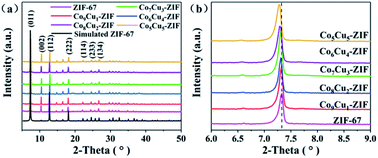Bimetallic CoCu-ZIF material for efficient visible light photocatalytic fuel denitrification
Abstract
Effective design of photocatalysts is an effective method to improve the separation of photogenerated carriers, which improves the photocatalytic performance of photocatalysts. In this work, CoCu-ZIF materials with bimetallic structure were synthesized at room temperature for efficient photocatalytic fuel denitrification. The properties and structures of CoCu-ZIF photocatalysts can be effectively controlled by adjusting the molar ratio of cobalt to copper. The as-prepared CoCu-ZIF photocatalysts were characterized by XRD, FT-IR, SEM, TEM, UV-vis, Raman, BET and other techniques. The photoactivity of CoCu-ZIF for the denitrogenation of NCCs has been evaluated using visible light (λ ≥ 420 nm). The results indicate that Co8Cu2-ZIF photocatalysts exhibit excellent photocatalytic properties, in which the denitrification rate almost reached 80% after 4 hours under visible light irradiation, which is higher than the degradation ability of ZIF-67 (38%). Transient photoelectrochemical experiments and EIS Nyquist plots indicate that Co8Cu2-ZIF with unique structure efficiently improves the separation and transfer of photogenerated electron–hole pairs. Moreover, a possible reaction mechanism was proposed by LC-MS analysis.



 Please wait while we load your content...
Please wait while we load your content...